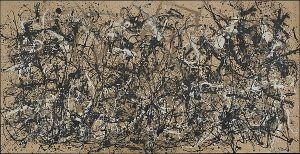 Jackson Pollock (American, 1912-1956), Autumn Rhythm, 1950, enamel paint on canvas, 105 x 207 in. Metropolitan Museum of Art
Jackson Pollock (American, 1912-1956), Autumn Rhythm, 1950, enamel paint on canvas, 105 x 207 in. Metropolitan Museum of Art
Abstract Expressionism
Abstract Expressionism develops in the 1940s in New York City. It is the first genuinely modern art style developed in America. Until this time, American artists had followed the developments of the Europeans rather than developing their own avant-garde styles. With Abstract Expressionism, the focus of the art world shifted from Paris to New York.
Abstract Expressionism develops out of many different ideas and influences. Some of these influences come from contact between the New York based artists who meet leading European artists who have escaped from war-torn Europe arriving in New York. World War II begins in Europe in the late-1930s lasting until 1945. Other major ideas and influences that result in Abstract Expressionism are due to uniquely American traits, ideas, and circumstances in the United States.
Each of the leading Abstract Expressionist artists has individual ideas, influences, concerns, and techniques in making their artworks. We should analyze their individual motivations and influences as well as understanding what larger ideas associated with Abstract Expressionism as a broader style is evident in their work.
As you do the following readings and videos, all of the ‘writing’ indicated within these instructions is to synthesize the information. Draft your written responses in your notes as you go. There is a brief compilation assignment at the end that will be based on this information so be thorough as you proceed in your note-taking.
Read about Abstract Expressionism on theartstory.org (click on the downward arrow to expand the essay at the bottom):
http://www.theartstory.org/movement-abstract-expressionism.htm
WRITING: Begin writing down major ideas, terms and vocabulary in your notes to begin to form a definition of Abstract Expression and the techniques and characteristics associated with Abstract Expressionist artworks. Also write down the names of major artists and important terms associated with them as they are discussed.
Read Khan Academy’s essays and watch videos in section ‘Abstract Expressionism and the New York School’ including ‘Abstract Expressionism: An Introduction’ – LINK: https://www.khanacademy.org/humanities/art-1010/abstract-exp-nyschool/abstract-expressionism/a/abstract-expressionism-an-introduction
Watch this video about Barnet Newman’s Vir Heroicus Subliminus:
On Kahn Academy, watch video for Newman’s Onement I, 1948:
WRITING (Question 1): In a few sentences, write what the speaker, Dr. Steven Zucker, says he feels is most important about the making and meaning of this painting.
- Watch video, ‘Barnett Newman’:
WRITING (Question 2): In a few sentences, write what the speaker tells us Barnett Newman was trying to communicate in Onement I and what in a broader sense, the Abstract Expressionists as a group were seeking to communicate.
- Watch video, ‘The Painting Techniques of Barnett Newman’:
- Watch the video, “Mark Rothko”:
WRITING (Question 3): In a few sentences or phrases, write out the terms and their meaning that the speaker uses to explain the mood or feeling of Rothko’s paintings.
WRITING (Question 4): What does the narrator explain about Rothko’s sense of composition that applies to all of the works of the Abstract Expressionists? How is this different in terms of composition and figure/ground from other art styles we have studied? Can you think of other styles or art movements we have studied that function similarly in terms of the role of the image within the overall structure of the composition.
- Watch the video, ‘The Painting Techniques of Mark Rothko’:
- Watch the video, ‘Why is that Important? Looking at Jackson Pollock’:
WRITING (Question 5): In a few sentences, summarize what the speaker explains about this being the first example of a type of painting related to Abstract Expressionism. How does the term used to describe this type of painting relate to its technique? Be specific, considering different aspects of how this painting was made and its appearance.
Read the Met’s essay about Abstract Expressionism – LINK: http://www.metmuseum.org/toah/hd/abex/hd_abex.htm
Pay attention to and update your notes to include artists (listed below) not yet discussed in depth on Khan Academy and artstory.org and the ideas that relate to their work within Abstract Expressionism.
For all these artists, click on and read the information related to their individual artworks in the slideshow that accompanies the Met’s essay.
Artists: Willem de Kooning, Clyfford Still, Richard Pousette-Dart, Franz Kline, David Smith, Robert Motherwell.
The Met’s essay breaks down Abstract Expressionism into two distinct categories – action painting (also called gesture painting) and color field painting. Make sure your notes reflect these two categories with good terms and explanations for the two different varieties.
WRITING / NOTE-TAKING HOMEWORK:
Considering Abstract Expressionism as a whole and within its historical, political, social and artistic context:
- Compile a list of approximately 5-8 bullet points of information that lists the most significant and important sources, influences, and reasons that Abstract Expressionism developed where and when it did.
- Next, compile and synthesize all the Khan Academy and artstory material with the Met’s essay into two lists, one for action painting and one for color field. Include approximately 5-7 points of information in each list of the most significant elements and characteristics of that type of Abstract Expressionism. At the bottom of each list, include the names of the artists associated with this variation or type of Abstract Expressionism.
For class next week – summary of the 1 required thing to do:
- Read and take notes on Abstract Expressionism. Complete the short answer questions and lists as described in the above instructions. Bring these short answers and the lists to class for peer-review and discussion.


